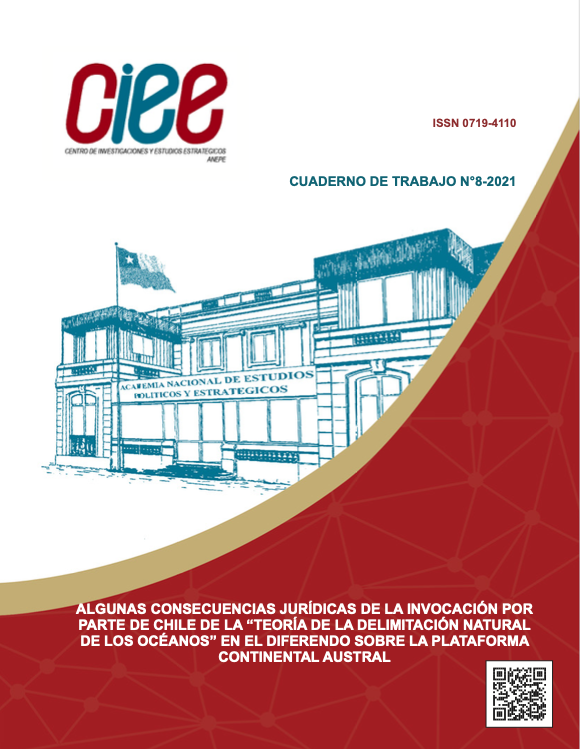SOME LEGAL CONSEQUENCES OF CHILE’S INVOCATION OF THE “THEORY OF NATURAL OCEAN DELIMITATION” IN THE DISPUTE OVER THE SOUTHERN CONTINENTAL SHELF
Main Article Content
Abstract
This article presents the so-called “Theory of the Natural Delimitation of the Oceans” and some of its implications for Chile (and Argentina) in the current scenario. Thus, the working premise is that there is evidence and sufficient arguments to substantiate the extension of the Pacific Ocean to the south of the American continent tip. With this, we affirm that the application of the “Theory of the Natural Delimitation of the Oceans” -particularly around the “Drake Passage”- allows Chile to establish an advantageous legal position vis-à-vis Argentina in the current dispute over the “Southern Continental Shelf Crescent”.
Given the above, we will then review some relevant legal consequences for Chile, which the geographical confirmation that the Pacific Ocean extends to the east of the “Cape Horn Meridian” would have in the afore mentioned conflict.
Finally, we also note that this article uses a qualitative-descriptive methodology, based on open sources, including international instruments such as the United Nations Convention on the Law of the Sea (UNCLOS), specialized texts and scientific and historiographical contributions on the subject.
Article Details
Downloads

This work is licensed under a Creative Commons Attribution-NoDerivatives 4.0 International License.
Los autores mantienen en todo momento los derechos sobre sus respectivos artículos, por otra parte, la Revista Cuaderno de Trabajo está distribuida bajo una Licencia Creative Commons Atribución 4.0 Internacional.
References
BARROS, Guillermo. El Arco de Scotia Separación Natural de los Océanos. En: Revista Marina, 1987.
Comisión Nacional para el Límite Exterior de la Plataforma Continental (COPLA) Argentina. Sitio web: http://www.plataformaargentina.gov.ar/es/mapaPlataforma. (Consultado al día 10 de agosto de 2021).
Convención de las Naciones Unidas Sobre el Derecho del Mar, 1982.
Decreto Supremo N° 95 de 23-08-2021, publicado en el Diario Oficial de Chile el día viernes 27 de agosto de 2021.
EAGLES, G. y JOKAT, W. Tectonic reconstructions for paleobathymetry in Drake Passage, Tectonophysics, Vol. 611, Elsevier, 2014.
EAGLES, G., Tectonic reconstruction of the southernmost Andes and the Scotia Sea during the opening of the Drake passage. En: geodynamic evolution of the southernmost Andes connection with the Scotia Arc., Springer Earth System Science, Spriger, 2016.
FITZGERALD, P. Tectonics and landscape evolution of the Antarctic plate since the breakup of Gondwana, eith an emphasis on the West Antarctic Rift System and the Tranantarctic muntains. Royal Soc. of New Zealand Bulletin, 35, p. 453-469, 2002.
BOHOYO, Fernando; GALINDO-ZALDÍVAR, Jesús; MAESTRO, Adolfo; ESCUTIA, Carlota;
MALDONADO, Andrés; LÓPEZ-MARTÍNEZ Jerónimo y Grupo de Investigación Antártica. Tectónica de Placas y Clima: la formación del Paso de Drake (Antártida). AEPECT 27.3-2019.
HORTON, Jennifer. En sitio web: https://science.howstuffworks.com/environmental/earth/oceanography/ocean-current3.htm#:~:text=Deep%20Ocean%20Currents%20(Global%20Conveyor%20Belt). (Consultado al día 29 de septiembre de 2021).
International Court of Justice. Temple of Preah Vihear (Cambodia v. Thailand). 1962. En sitio web: https://www.icj-cij.org/en/case/45. (Consultado al día 29 de septiembre de 2021).
International Hydrographic Organization, Limits of Oceans and Seas, 1953.
International Hydrograpic Organization. En sitio web: https://unstats.un.org/unsd/geoinfo/ungegn/docs/25th-gegn-docs/wp%20papers/wp81%20-%20iho%20report.pdf. (Consultado al día 27 de septiembre de 2021).
LAGABRIELLE, Y., Y. GODDERIES, Y. DONNADIEU, J. MALAVIELLE y M. SUÁREZ, The tectonic history of Drake Passage and its posible impacts on global climate, Earth & Planetary Sci. Letters, vol. 279, N°. 3 y 4, 2009.
Medio Digital Pauta. Plataforma continental: la última tensión entre Chile y Argentina. En sitio web: https://www.pauta.cl/politica/plataforma-continental-tension-diplomacia-chile-argentina. (Consultado al día 29 de septiembre de 2021).
National Geographic Society. There’s a new ocean now—can you name all 5? En sitio web: https://www.nationalgeographic.com/environment/article/theres-a-new-ocean-now-can-you-name-all-five-southern-ocean. (Consultado al día 29 de septiembre de 2021).
PECOURT, Enrique. El Principio de «Estoppel» en Derecho Internacional Público. En: Revista Española de Derecho Internacional , 1962, Vol. 15, N° 1/2 (1962), pp. 97-139.
PIDWIRNY, Michael. En sitio web: http://www.physicalgeography.net/fundamentals/8q_1.html (Consultado al día 29 de septiembre de 2021).
SABATÉ, Domingo. Problemas argentinos de soberanía territorial. Cooperadora de Derecho y Ciencia Sociales. Buenos Aires, 1976. 316p. p. 209.
SANTIBÁÑEZ, Rafael, Los Derechos de Chile en el Beagle. Ed. Andrés Bello, 1969.
Tratado de Paz y Amistad entre el Gobierno de la República de Chile y el Gobierno de la República de Argentina, 1984.
